Emergency Preparedness: Principles, Frameworks, Community Roles
VerifiedAdded on 2023/06/12
|12
|3186
|271
Essay
AI Summary
This essay provides a comprehensive evaluation of emergency preparedness and response within healthcare contexts, focusing on the guiding principles that prioritize community service, health restoration, and community participation. It assesses the efficacy of existing frameworks, highlighting the importance of community involvement, political goodwill, and strong partnerships between government and local communities. The essay emphasizes the complementary relationship between health systems and emergency preparedness, advocating for all-hazards planning based on risk assessment. It further discusses the strategic approaches necessary for effective preparedness, including operational readiness and health systems resilience, underlining the need for continuous infrastructure updates, well-trained and equipped workforce, and robust financial support. Finally, the essay examines the crucial role of community, interdisciplinary, and intersectoral relationships in fostering a collaborative environment for successful emergency and disaster response, drawing examples from real-world rescue operations.
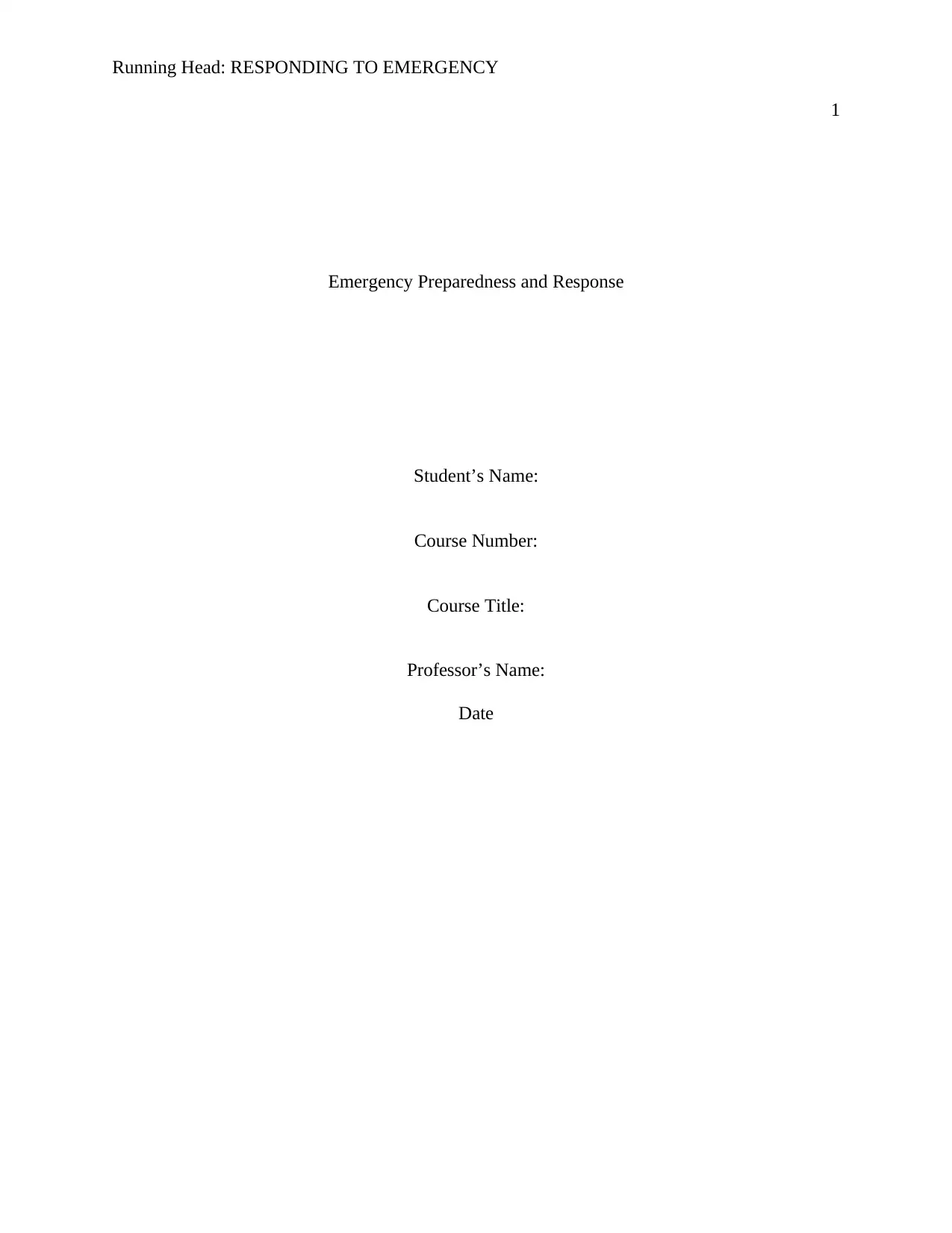
Running Head: RESPONDING TO EMERGENCY
1
Emergency Preparedness and Response
Student’s Name:
Course Number:
Course Title:
Professor’s Name:
Date
1
Emergency Preparedness and Response
Student’s Name:
Course Number:
Course Title:
Professor’s Name:
Date
Paraphrase This Document
Need a fresh take? Get an instant paraphrase of this document with our AI Paraphraser

RESPONDING TO EMERGENCY 2
Introduction
Emergency preparedness is an area which is taken seriously in the context of health care.
The facilities and the staff normally play a crucial role in the preparedness of disaster or
emergency and the response efforts. This is in respect to any disaster which may affect the
healthcare facility be it a manmade disaster or a natural calamity. This also includes acts of
terrorism and pandemic outbreaks. This paper aims to evaluate the principles which are
applicable in the healthcare contexts in relation to the emergency and disaster preparedness. The
paper will also evaluate the efficacy of the frameworks in relation to meeting the objectives of
preparedness and response in the healthcare contexts. The paper will also evaluate the
relationships which are crucial in the community with respect to the preparedness, mitigation,
prevention, and response.
Principles of Emergency Preparedness and Response
The principles which guide the frameworks on the emergency and disaster preparedness
and response are normally focused on the service to the community. The aim of the principles is
to ensure that there is efficient preparedness to an emergency situation. The principles are also
focused on the quick and efficient response to an emergency situation as noted that emergency
preparedness and response is geared towards community service and the protection of human
life, the first and the most important principle in the emergency preparedness and response is the
safeguarding and the restoration of the health of the communities (Veenema, 2006). This
principle is stressed in those areas where there is a high risk of disasters occurring. The aim is to
increase the preparedness and the response of the higher-risk areas.
The second principle is in respect to the participation of the community. Without the
involving of the larger community, the healthcare facilities would have futile efforts in the
Introduction
Emergency preparedness is an area which is taken seriously in the context of health care.
The facilities and the staff normally play a crucial role in the preparedness of disaster or
emergency and the response efforts. This is in respect to any disaster which may affect the
healthcare facility be it a manmade disaster or a natural calamity. This also includes acts of
terrorism and pandemic outbreaks. This paper aims to evaluate the principles which are
applicable in the healthcare contexts in relation to the emergency and disaster preparedness. The
paper will also evaluate the efficacy of the frameworks in relation to meeting the objectives of
preparedness and response in the healthcare contexts. The paper will also evaluate the
relationships which are crucial in the community with respect to the preparedness, mitigation,
prevention, and response.
Principles of Emergency Preparedness and Response
The principles which guide the frameworks on the emergency and disaster preparedness
and response are normally focused on the service to the community. The aim of the principles is
to ensure that there is efficient preparedness to an emergency situation. The principles are also
focused on the quick and efficient response to an emergency situation as noted that emergency
preparedness and response is geared towards community service and the protection of human
life, the first and the most important principle in the emergency preparedness and response is the
safeguarding and the restoration of the health of the communities (Veenema, 2006). This
principle is stressed in those areas where there is a high risk of disasters occurring. The aim is to
increase the preparedness and the response of the higher-risk areas.
The second principle is in respect to the participation of the community. Without the
involving of the larger community, the healthcare facilities would have futile efforts in the
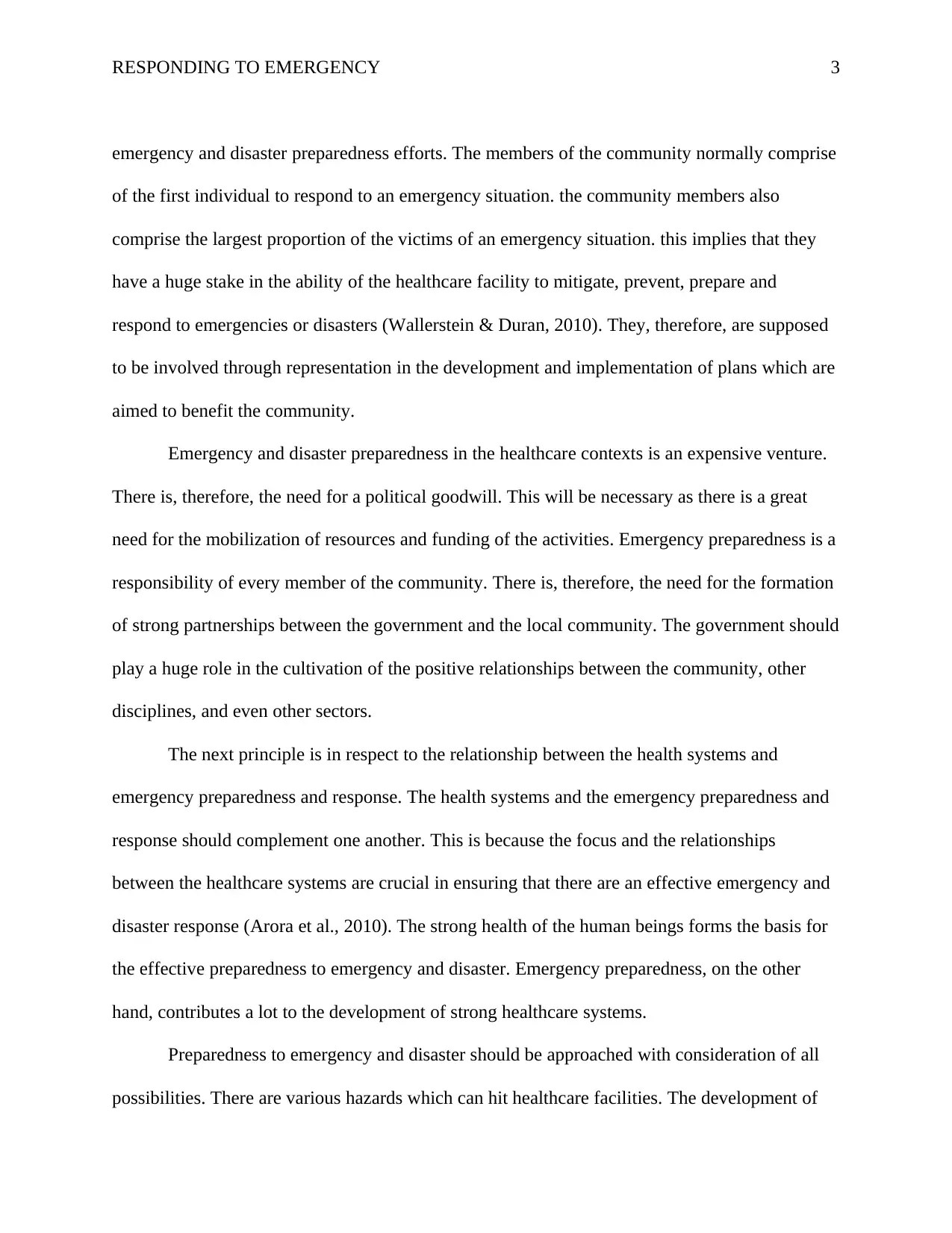
RESPONDING TO EMERGENCY 3
emergency and disaster preparedness efforts. The members of the community normally comprise
of the first individual to respond to an emergency situation. the community members also
comprise the largest proportion of the victims of an emergency situation. this implies that they
have a huge stake in the ability of the healthcare facility to mitigate, prevent, prepare and
respond to emergencies or disasters (Wallerstein & Duran, 2010). They, therefore, are supposed
to be involved through representation in the development and implementation of plans which are
aimed to benefit the community.
Emergency and disaster preparedness in the healthcare contexts is an expensive venture.
There is, therefore, the need for a political goodwill. This will be necessary as there is a great
need for the mobilization of resources and funding of the activities. Emergency preparedness is a
responsibility of every member of the community. There is, therefore, the need for the formation
of strong partnerships between the government and the local community. The government should
play a huge role in the cultivation of the positive relationships between the community, other
disciplines, and even other sectors.
The next principle is in respect to the relationship between the health systems and
emergency preparedness and response. The health systems and the emergency preparedness and
response should complement one another. This is because the focus and the relationships
between the healthcare systems are crucial in ensuring that there are an effective emergency and
disaster response (Arora et al., 2010). The strong health of the human beings forms the basis for
the effective preparedness to emergency and disaster. Emergency preparedness, on the other
hand, contributes a lot to the development of strong healthcare systems.
Preparedness to emergency and disaster should be approached with consideration of all
possibilities. There are various hazards which can hit healthcare facilities. The development of
emergency and disaster preparedness efforts. The members of the community normally comprise
of the first individual to respond to an emergency situation. the community members also
comprise the largest proportion of the victims of an emergency situation. this implies that they
have a huge stake in the ability of the healthcare facility to mitigate, prevent, prepare and
respond to emergencies or disasters (Wallerstein & Duran, 2010). They, therefore, are supposed
to be involved through representation in the development and implementation of plans which are
aimed to benefit the community.
Emergency and disaster preparedness in the healthcare contexts is an expensive venture.
There is, therefore, the need for a political goodwill. This will be necessary as there is a great
need for the mobilization of resources and funding of the activities. Emergency preparedness is a
responsibility of every member of the community. There is, therefore, the need for the formation
of strong partnerships between the government and the local community. The government should
play a huge role in the cultivation of the positive relationships between the community, other
disciplines, and even other sectors.
The next principle is in respect to the relationship between the health systems and
emergency preparedness and response. The health systems and the emergency preparedness and
response should complement one another. This is because the focus and the relationships
between the healthcare systems are crucial in ensuring that there are an effective emergency and
disaster response (Arora et al., 2010). The strong health of the human beings forms the basis for
the effective preparedness to emergency and disaster. Emergency preparedness, on the other
hand, contributes a lot to the development of strong healthcare systems.
Preparedness to emergency and disaster should be approached with consideration of all
possibilities. There are various hazards which can hit healthcare facilities. The development of
⊘ This is a preview!⊘
Do you want full access?
Subscribe today to unlock all pages.

Trusted by 1+ million students worldwide
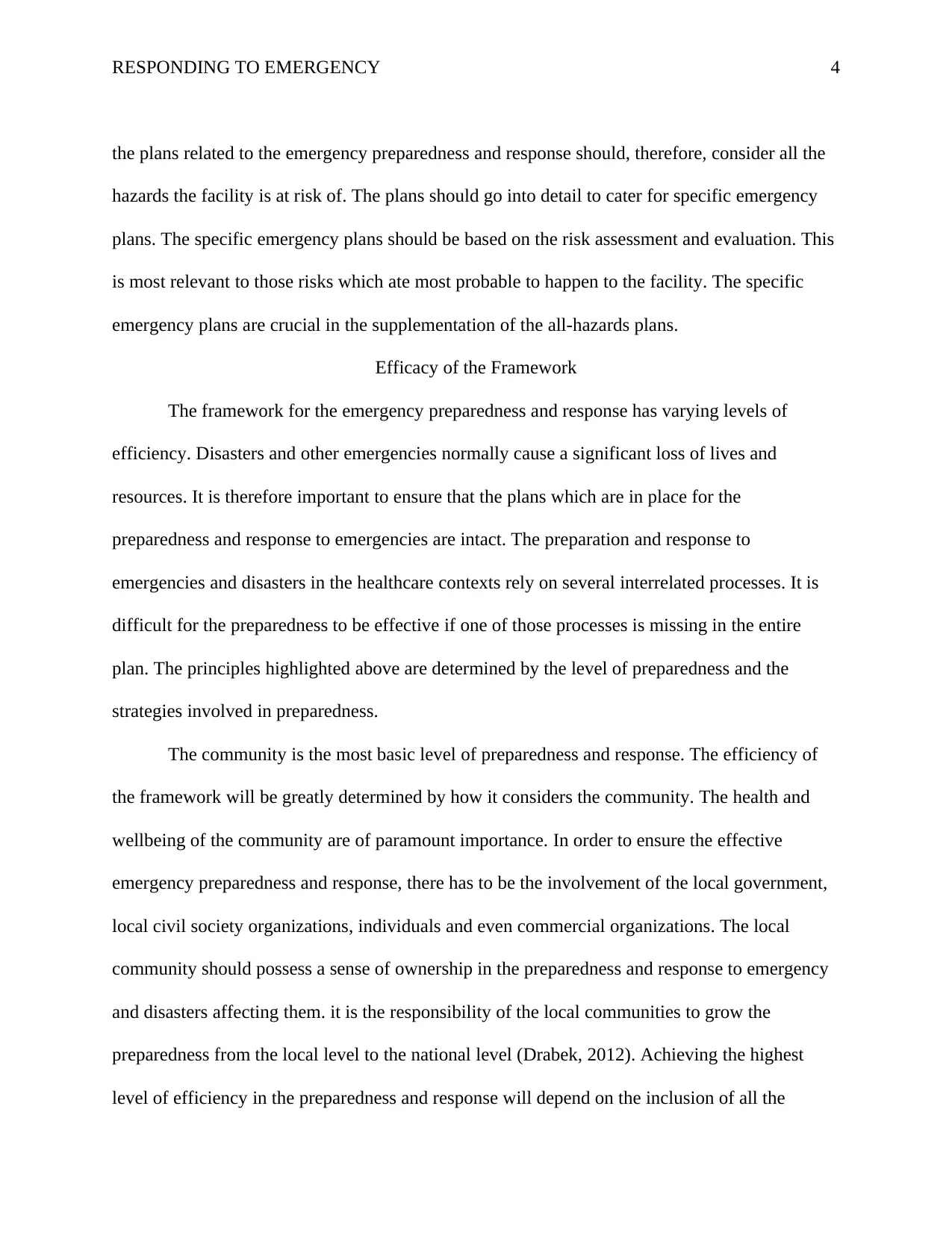
RESPONDING TO EMERGENCY 4
the plans related to the emergency preparedness and response should, therefore, consider all the
hazards the facility is at risk of. The plans should go into detail to cater for specific emergency
plans. The specific emergency plans should be based on the risk assessment and evaluation. This
is most relevant to those risks which ate most probable to happen to the facility. The specific
emergency plans are crucial in the supplementation of the all-hazards plans.
Efficacy of the Framework
The framework for the emergency preparedness and response has varying levels of
efficiency. Disasters and other emergencies normally cause a significant loss of lives and
resources. It is therefore important to ensure that the plans which are in place for the
preparedness and response to emergencies are intact. The preparation and response to
emergencies and disasters in the healthcare contexts rely on several interrelated processes. It is
difficult for the preparedness to be effective if one of those processes is missing in the entire
plan. The principles highlighted above are determined by the level of preparedness and the
strategies involved in preparedness.
The community is the most basic level of preparedness and response. The efficiency of
the framework will be greatly determined by how it considers the community. The health and
wellbeing of the community are of paramount importance. In order to ensure the effective
emergency preparedness and response, there has to be the involvement of the local government,
local civil society organizations, individuals and even commercial organizations. The local
community should possess a sense of ownership in the preparedness and response to emergency
and disasters affecting them. it is the responsibility of the local communities to grow the
preparedness from the local level to the national level (Drabek, 2012). Achieving the highest
level of efficiency in the preparedness and response will depend on the inclusion of all the
the plans related to the emergency preparedness and response should, therefore, consider all the
hazards the facility is at risk of. The plans should go into detail to cater for specific emergency
plans. The specific emergency plans should be based on the risk assessment and evaluation. This
is most relevant to those risks which ate most probable to happen to the facility. The specific
emergency plans are crucial in the supplementation of the all-hazards plans.
Efficacy of the Framework
The framework for the emergency preparedness and response has varying levels of
efficiency. Disasters and other emergencies normally cause a significant loss of lives and
resources. It is therefore important to ensure that the plans which are in place for the
preparedness and response to emergencies are intact. The preparation and response to
emergencies and disasters in the healthcare contexts rely on several interrelated processes. It is
difficult for the preparedness to be effective if one of those processes is missing in the entire
plan. The principles highlighted above are determined by the level of preparedness and the
strategies involved in preparedness.
The community is the most basic level of preparedness and response. The efficiency of
the framework will be greatly determined by how it considers the community. The health and
wellbeing of the community are of paramount importance. In order to ensure the effective
emergency preparedness and response, there has to be the involvement of the local government,
local civil society organizations, individuals and even commercial organizations. The local
community should possess a sense of ownership in the preparedness and response to emergency
and disasters affecting them. it is the responsibility of the local communities to grow the
preparedness from the local level to the national level (Drabek, 2012). Achieving the highest
level of efficiency in the preparedness and response will depend on the inclusion of all the
Paraphrase This Document
Need a fresh take? Get an instant paraphrase of this document with our AI Paraphraser
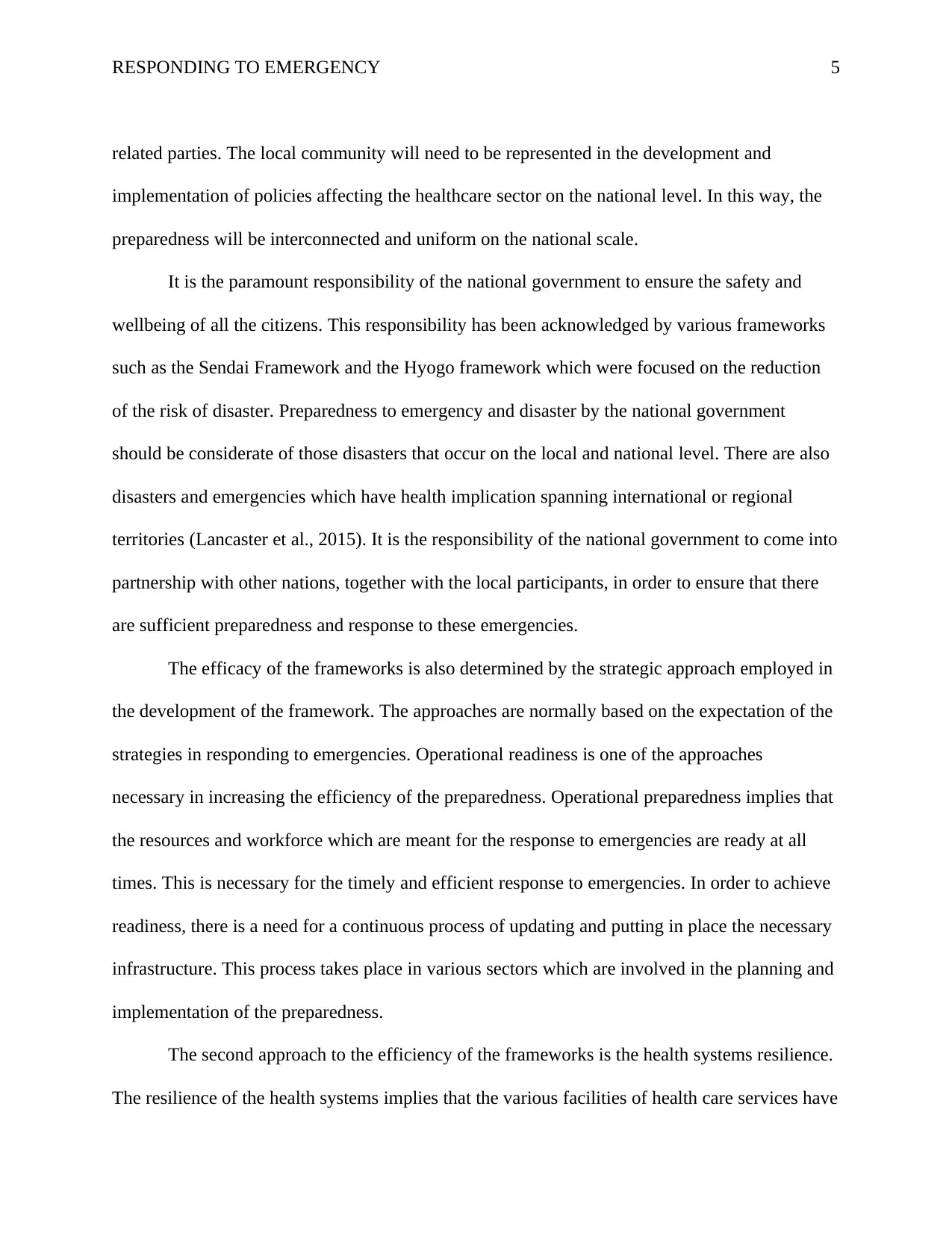
RESPONDING TO EMERGENCY 5
related parties. The local community will need to be represented in the development and
implementation of policies affecting the healthcare sector on the national level. In this way, the
preparedness will be interconnected and uniform on the national scale.
It is the paramount responsibility of the national government to ensure the safety and
wellbeing of all the citizens. This responsibility has been acknowledged by various frameworks
such as the Sendai Framework and the Hyogo framework which were focused on the reduction
of the risk of disaster. Preparedness to emergency and disaster by the national government
should be considerate of those disasters that occur on the local and national level. There are also
disasters and emergencies which have health implication spanning international or regional
territories (Lancaster et al., 2015). It is the responsibility of the national government to come into
partnership with other nations, together with the local participants, in order to ensure that there
are sufficient preparedness and response to these emergencies.
The efficacy of the frameworks is also determined by the strategic approach employed in
the development of the framework. The approaches are normally based on the expectation of the
strategies in responding to emergencies. Operational readiness is one of the approaches
necessary in increasing the efficiency of the preparedness. Operational preparedness implies that
the resources and workforce which are meant for the response to emergencies are ready at all
times. This is necessary for the timely and efficient response to emergencies. In order to achieve
readiness, there is a need for a continuous process of updating and putting in place the necessary
infrastructure. This process takes place in various sectors which are involved in the planning and
implementation of the preparedness.
The second approach to the efficiency of the frameworks is the health systems resilience.
The resilience of the health systems implies that the various facilities of health care services have
related parties. The local community will need to be represented in the development and
implementation of policies affecting the healthcare sector on the national level. In this way, the
preparedness will be interconnected and uniform on the national scale.
It is the paramount responsibility of the national government to ensure the safety and
wellbeing of all the citizens. This responsibility has been acknowledged by various frameworks
such as the Sendai Framework and the Hyogo framework which were focused on the reduction
of the risk of disaster. Preparedness to emergency and disaster by the national government
should be considerate of those disasters that occur on the local and national level. There are also
disasters and emergencies which have health implication spanning international or regional
territories (Lancaster et al., 2015). It is the responsibility of the national government to come into
partnership with other nations, together with the local participants, in order to ensure that there
are sufficient preparedness and response to these emergencies.
The efficacy of the frameworks is also determined by the strategic approach employed in
the development of the framework. The approaches are normally based on the expectation of the
strategies in responding to emergencies. Operational readiness is one of the approaches
necessary in increasing the efficiency of the preparedness. Operational preparedness implies that
the resources and workforce which are meant for the response to emergencies are ready at all
times. This is necessary for the timely and efficient response to emergencies. In order to achieve
readiness, there is a need for a continuous process of updating and putting in place the necessary
infrastructure. This process takes place in various sectors which are involved in the planning and
implementation of the preparedness.
The second approach to the efficiency of the frameworks is the health systems resilience.
The resilience of the health systems implies that the various facilities of health care services have
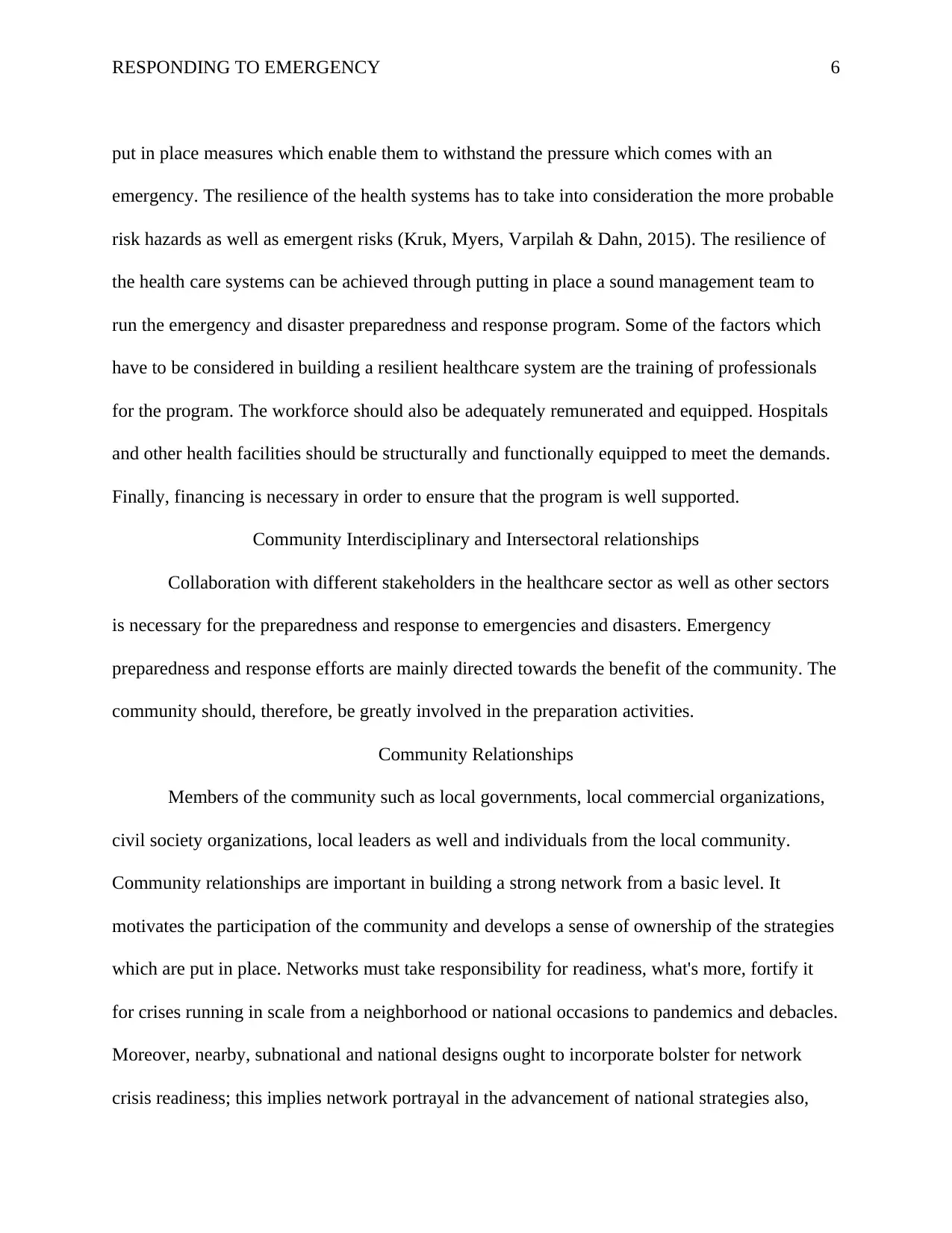
RESPONDING TO EMERGENCY 6
put in place measures which enable them to withstand the pressure which comes with an
emergency. The resilience of the health systems has to take into consideration the more probable
risk hazards as well as emergent risks (Kruk, Myers, Varpilah & Dahn, 2015). The resilience of
the health care systems can be achieved through putting in place a sound management team to
run the emergency and disaster preparedness and response program. Some of the factors which
have to be considered in building a resilient healthcare system are the training of professionals
for the program. The workforce should also be adequately remunerated and equipped. Hospitals
and other health facilities should be structurally and functionally equipped to meet the demands.
Finally, financing is necessary in order to ensure that the program is well supported.
Community Interdisciplinary and Intersectoral relationships
Collaboration with different stakeholders in the healthcare sector as well as other sectors
is necessary for the preparedness and response to emergencies and disasters. Emergency
preparedness and response efforts are mainly directed towards the benefit of the community. The
community should, therefore, be greatly involved in the preparation activities.
Community Relationships
Members of the community such as local governments, local commercial organizations,
civil society organizations, local leaders as well and individuals from the local community.
Community relationships are important in building a strong network from a basic level. It
motivates the participation of the community and develops a sense of ownership of the strategies
which are put in place. Networks must take responsibility for readiness, what's more, fortify it
for crises running in scale from a neighborhood or national occasions to pandemics and debacles.
Moreover, nearby, subnational and national designs ought to incorporate bolster for network
crisis readiness; this implies network portrayal in the advancement of national strategies also,
put in place measures which enable them to withstand the pressure which comes with an
emergency. The resilience of the health systems has to take into consideration the more probable
risk hazards as well as emergent risks (Kruk, Myers, Varpilah & Dahn, 2015). The resilience of
the health care systems can be achieved through putting in place a sound management team to
run the emergency and disaster preparedness and response program. Some of the factors which
have to be considered in building a resilient healthcare system are the training of professionals
for the program. The workforce should also be adequately remunerated and equipped. Hospitals
and other health facilities should be structurally and functionally equipped to meet the demands.
Finally, financing is necessary in order to ensure that the program is well supported.
Community Interdisciplinary and Intersectoral relationships
Collaboration with different stakeholders in the healthcare sector as well as other sectors
is necessary for the preparedness and response to emergencies and disasters. Emergency
preparedness and response efforts are mainly directed towards the benefit of the community. The
community should, therefore, be greatly involved in the preparation activities.
Community Relationships
Members of the community such as local governments, local commercial organizations,
civil society organizations, local leaders as well and individuals from the local community.
Community relationships are important in building a strong network from a basic level. It
motivates the participation of the community and develops a sense of ownership of the strategies
which are put in place. Networks must take responsibility for readiness, what's more, fortify it
for crises running in scale from a neighborhood or national occasions to pandemics and debacles.
Moreover, nearby, subnational and national designs ought to incorporate bolster for network
crisis readiness; this implies network portrayal in the advancement of national strategies also,
⊘ This is a preview!⊘
Do you want full access?
Subscribe today to unlock all pages.

Trusted by 1+ million students worldwide
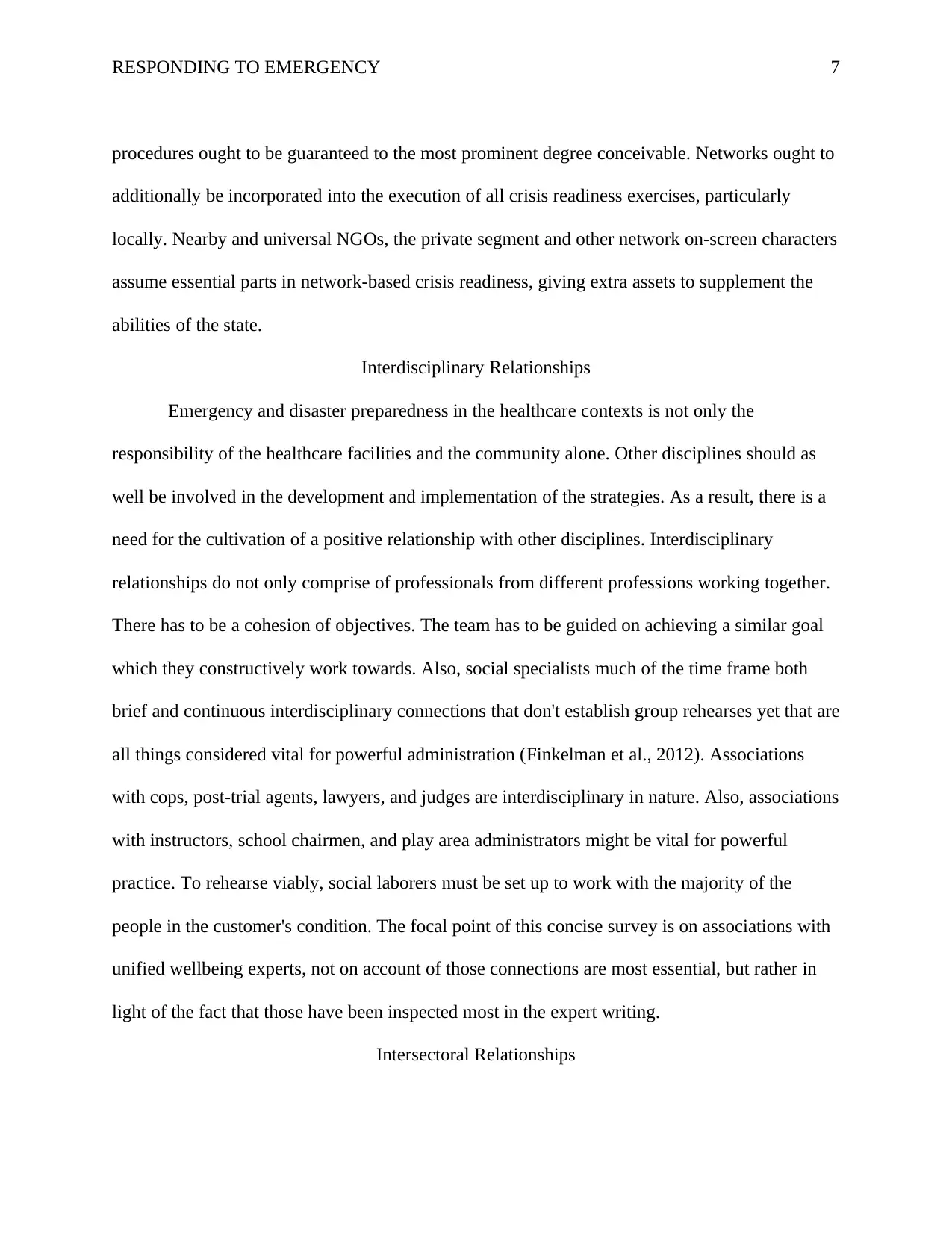
RESPONDING TO EMERGENCY 7
procedures ought to be guaranteed to the most prominent degree conceivable. Networks ought to
additionally be incorporated into the execution of all crisis readiness exercises, particularly
locally. Nearby and universal NGOs, the private segment and other network on-screen characters
assume essential parts in network-based crisis readiness, giving extra assets to supplement the
abilities of the state.
Interdisciplinary Relationships
Emergency and disaster preparedness in the healthcare contexts is not only the
responsibility of the healthcare facilities and the community alone. Other disciplines should as
well be involved in the development and implementation of the strategies. As a result, there is a
need for the cultivation of a positive relationship with other disciplines. Interdisciplinary
relationships do not only comprise of professionals from different professions working together.
There has to be a cohesion of objectives. The team has to be guided on achieving a similar goal
which they constructively work towards. Also, social specialists much of the time frame both
brief and continuous interdisciplinary connections that don't establish group rehearses yet that are
all things considered vital for powerful administration (Finkelman et al., 2012). Associations
with cops, post-trial agents, lawyers, and judges are interdisciplinary in nature. Also, associations
with instructors, school chairmen, and play area administrators might be vital for powerful
practice. To rehearse viably, social laborers must be set up to work with the majority of the
people in the customer's condition. The focal point of this concise survey is on associations with
unified wellbeing experts, not on account of those connections are most essential, but rather in
light of the fact that those have been inspected most in the expert writing.
Intersectoral Relationships
procedures ought to be guaranteed to the most prominent degree conceivable. Networks ought to
additionally be incorporated into the execution of all crisis readiness exercises, particularly
locally. Nearby and universal NGOs, the private segment and other network on-screen characters
assume essential parts in network-based crisis readiness, giving extra assets to supplement the
abilities of the state.
Interdisciplinary Relationships
Emergency and disaster preparedness in the healthcare contexts is not only the
responsibility of the healthcare facilities and the community alone. Other disciplines should as
well be involved in the development and implementation of the strategies. As a result, there is a
need for the cultivation of a positive relationship with other disciplines. Interdisciplinary
relationships do not only comprise of professionals from different professions working together.
There has to be a cohesion of objectives. The team has to be guided on achieving a similar goal
which they constructively work towards. Also, social specialists much of the time frame both
brief and continuous interdisciplinary connections that don't establish group rehearses yet that are
all things considered vital for powerful administration (Finkelman et al., 2012). Associations
with cops, post-trial agents, lawyers, and judges are interdisciplinary in nature. Also, associations
with instructors, school chairmen, and play area administrators might be vital for powerful
practice. To rehearse viably, social laborers must be set up to work with the majority of the
people in the customer's condition. The focal point of this concise survey is on associations with
unified wellbeing experts, not on account of those connections are most essential, but rather in
light of the fact that those have been inspected most in the expert writing.
Intersectoral Relationships
Paraphrase This Document
Need a fresh take? Get an instant paraphrase of this document with our AI Paraphraser
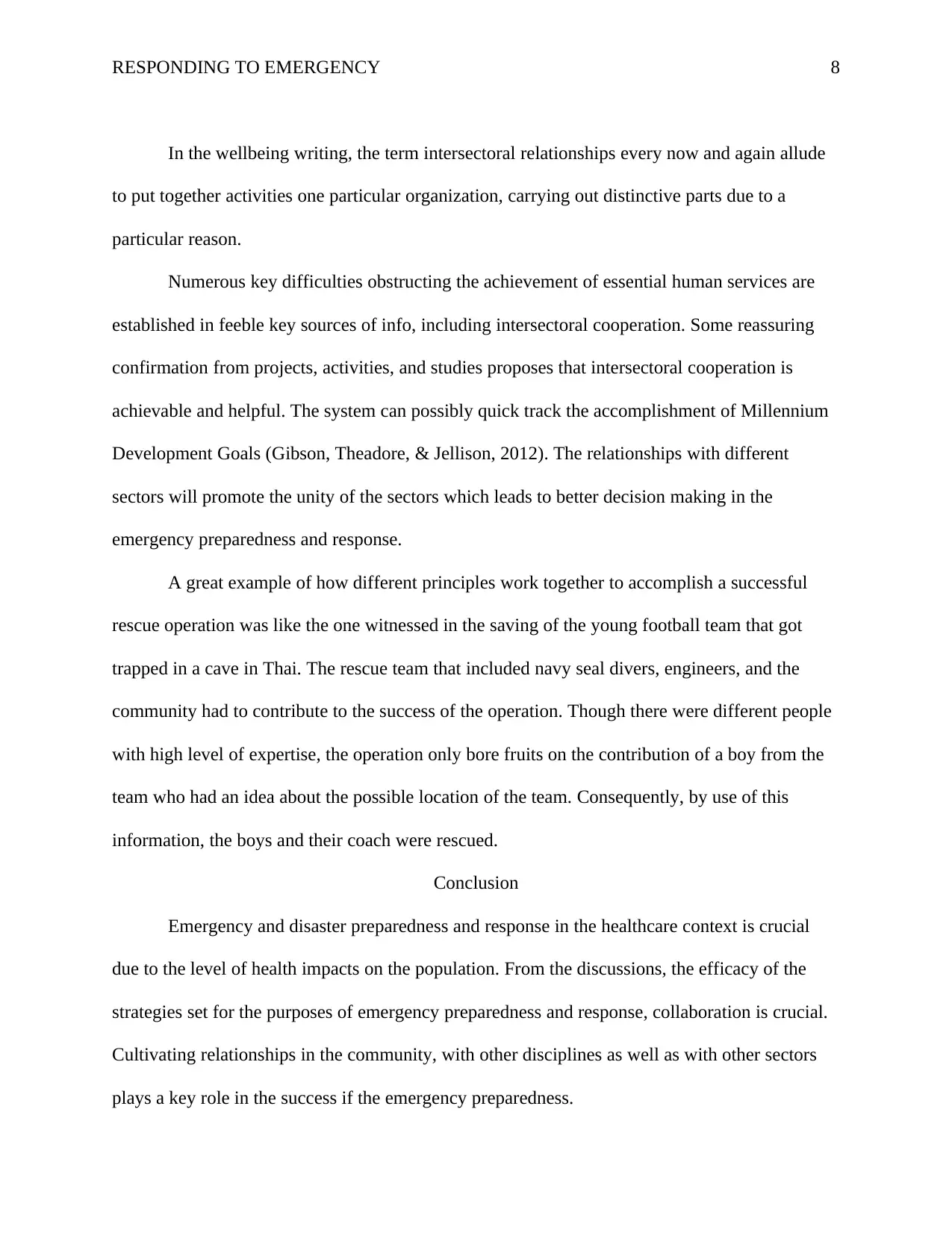
RESPONDING TO EMERGENCY 8
In the wellbeing writing, the term intersectoral relationships every now and again allude
to put together activities one particular organization, carrying out distinctive parts due to a
particular reason.
Numerous key difficulties obstructing the achievement of essential human services are
established in feeble key sources of info, including intersectoral cooperation. Some reassuring
confirmation from projects, activities, and studies proposes that intersectoral cooperation is
achievable and helpful. The system can possibly quick track the accomplishment of Millennium
Development Goals (Gibson, Theadore, & Jellison, 2012). The relationships with different
sectors will promote the unity of the sectors which leads to better decision making in the
emergency preparedness and response.
A great example of how different principles work together to accomplish a successful
rescue operation was like the one witnessed in the saving of the young football team that got
trapped in a cave in Thai. The rescue team that included navy seal divers, engineers, and the
community had to contribute to the success of the operation. Though there were different people
with high level of expertise, the operation only bore fruits on the contribution of a boy from the
team who had an idea about the possible location of the team. Consequently, by use of this
information, the boys and their coach were rescued.
Conclusion
Emergency and disaster preparedness and response in the healthcare context is crucial
due to the level of health impacts on the population. From the discussions, the efficacy of the
strategies set for the purposes of emergency preparedness and response, collaboration is crucial.
Cultivating relationships in the community, with other disciplines as well as with other sectors
plays a key role in the success if the emergency preparedness.
In the wellbeing writing, the term intersectoral relationships every now and again allude
to put together activities one particular organization, carrying out distinctive parts due to a
particular reason.
Numerous key difficulties obstructing the achievement of essential human services are
established in feeble key sources of info, including intersectoral cooperation. Some reassuring
confirmation from projects, activities, and studies proposes that intersectoral cooperation is
achievable and helpful. The system can possibly quick track the accomplishment of Millennium
Development Goals (Gibson, Theadore, & Jellison, 2012). The relationships with different
sectors will promote the unity of the sectors which leads to better decision making in the
emergency preparedness and response.
A great example of how different principles work together to accomplish a successful
rescue operation was like the one witnessed in the saving of the young football team that got
trapped in a cave in Thai. The rescue team that included navy seal divers, engineers, and the
community had to contribute to the success of the operation. Though there were different people
with high level of expertise, the operation only bore fruits on the contribution of a boy from the
team who had an idea about the possible location of the team. Consequently, by use of this
information, the boys and their coach were rescued.
Conclusion
Emergency and disaster preparedness and response in the healthcare context is crucial
due to the level of health impacts on the population. From the discussions, the efficacy of the
strategies set for the purposes of emergency preparedness and response, collaboration is crucial.
Cultivating relationships in the community, with other disciplines as well as with other sectors
plays a key role in the success if the emergency preparedness.

RESPONDING TO EMERGENCY 9
⊘ This is a preview!⊘
Do you want full access?
Subscribe today to unlock all pages.

Trusted by 1+ million students worldwide
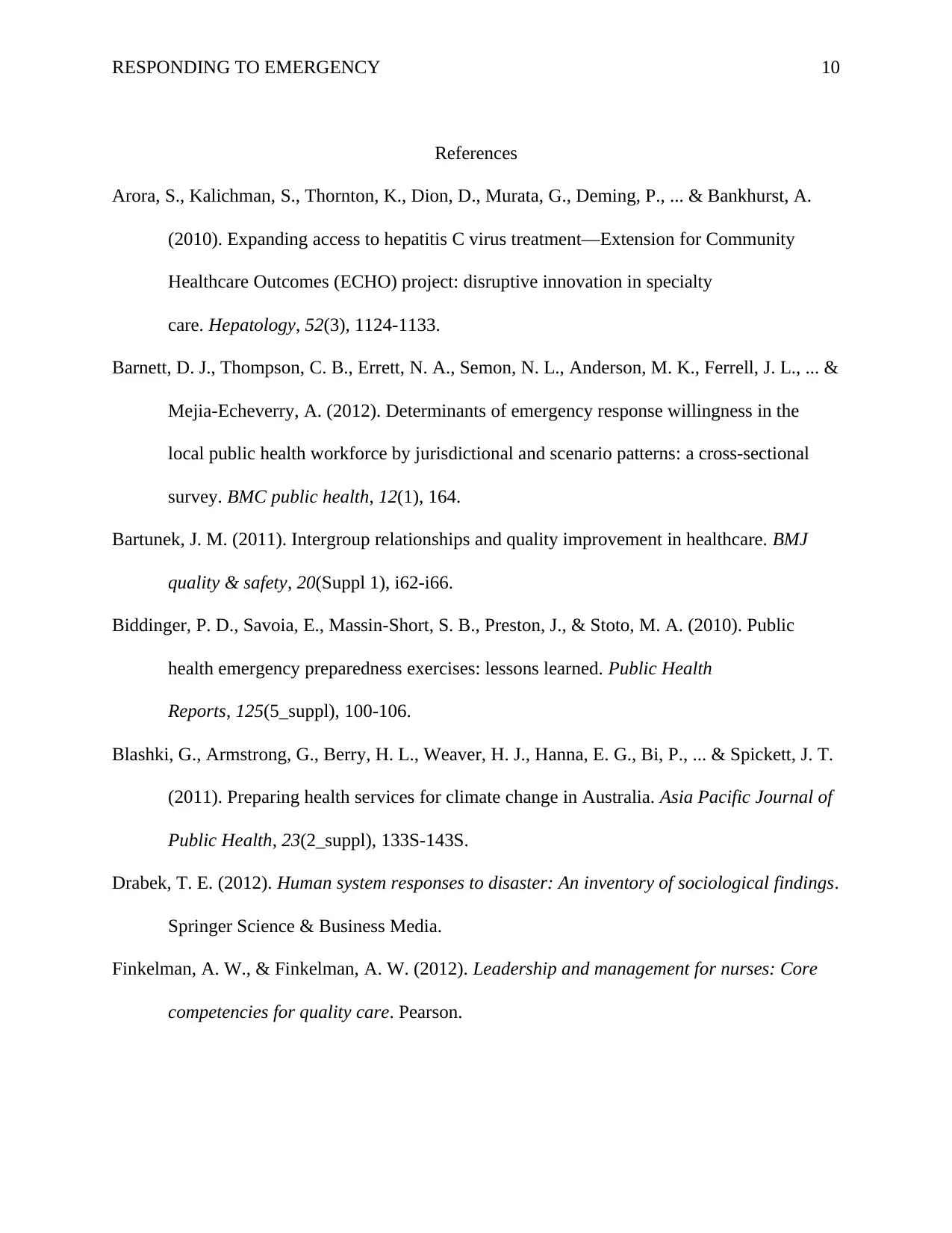
RESPONDING TO EMERGENCY 10
References
Arora, S., Kalichman, S., Thornton, K., Dion, D., Murata, G., Deming, P., ... & Bankhurst, A.
(2010). Expanding access to hepatitis C virus treatment—Extension for Community
Healthcare Outcomes (ECHO) project: disruptive innovation in specialty
care. Hepatology, 52(3), 1124-1133.
Barnett, D. J., Thompson, C. B., Errett, N. A., Semon, N. L., Anderson, M. K., Ferrell, J. L., ... &
Mejia-Echeverry, A. (2012). Determinants of emergency response willingness in the
local public health workforce by jurisdictional and scenario patterns: a cross-sectional
survey. BMC public health, 12(1), 164.
Bartunek, J. M. (2011). Intergroup relationships and quality improvement in healthcare. BMJ
quality & safety, 20(Suppl 1), i62-i66.
Biddinger, P. D., Savoia, E., Massin-Short, S. B., Preston, J., & Stoto, M. A. (2010). Public
health emergency preparedness exercises: lessons learned. Public Health
Reports, 125(5_suppl), 100-106.
Blashki, G., Armstrong, G., Berry, H. L., Weaver, H. J., Hanna, E. G., Bi, P., ... & Spickett, J. T.
(2011). Preparing health services for climate change in Australia. Asia Pacific Journal of
Public Health, 23(2_suppl), 133S-143S.
Drabek, T. E. (2012). Human system responses to disaster: An inventory of sociological findings.
Springer Science & Business Media.
Finkelman, A. W., & Finkelman, A. W. (2012). Leadership and management for nurses: Core
competencies for quality care. Pearson.
References
Arora, S., Kalichman, S., Thornton, K., Dion, D., Murata, G., Deming, P., ... & Bankhurst, A.
(2010). Expanding access to hepatitis C virus treatment—Extension for Community
Healthcare Outcomes (ECHO) project: disruptive innovation in specialty
care. Hepatology, 52(3), 1124-1133.
Barnett, D. J., Thompson, C. B., Errett, N. A., Semon, N. L., Anderson, M. K., Ferrell, J. L., ... &
Mejia-Echeverry, A. (2012). Determinants of emergency response willingness in the
local public health workforce by jurisdictional and scenario patterns: a cross-sectional
survey. BMC public health, 12(1), 164.
Bartunek, J. M. (2011). Intergroup relationships and quality improvement in healthcare. BMJ
quality & safety, 20(Suppl 1), i62-i66.
Biddinger, P. D., Savoia, E., Massin-Short, S. B., Preston, J., & Stoto, M. A. (2010). Public
health emergency preparedness exercises: lessons learned. Public Health
Reports, 125(5_suppl), 100-106.
Blashki, G., Armstrong, G., Berry, H. L., Weaver, H. J., Hanna, E. G., Bi, P., ... & Spickett, J. T.
(2011). Preparing health services for climate change in Australia. Asia Pacific Journal of
Public Health, 23(2_suppl), 133S-143S.
Drabek, T. E. (2012). Human system responses to disaster: An inventory of sociological findings.
Springer Science & Business Media.
Finkelman, A. W., & Finkelman, A. W. (2012). Leadership and management for nurses: Core
competencies for quality care. Pearson.
Paraphrase This Document
Need a fresh take? Get an instant paraphrase of this document with our AI Paraphraser
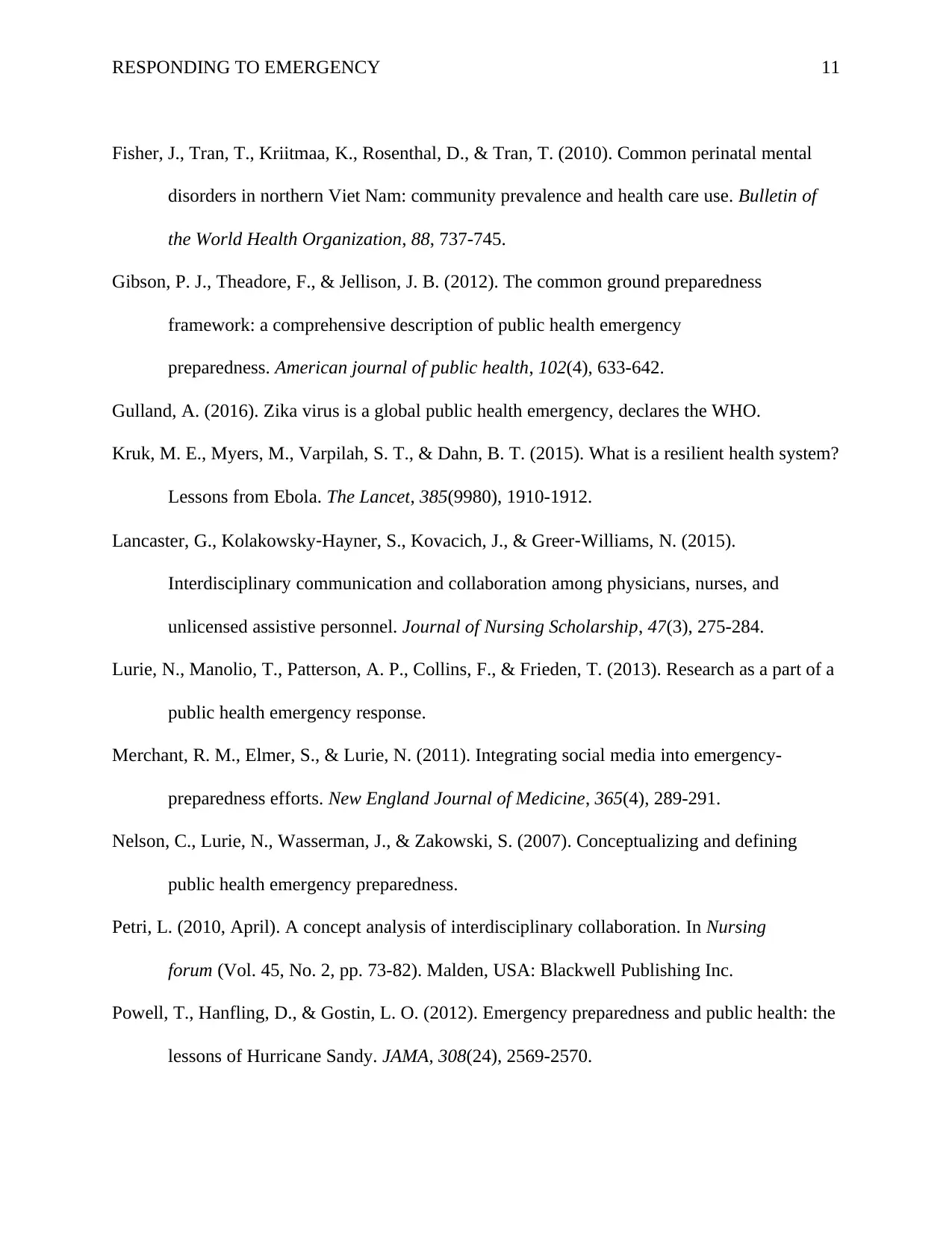
RESPONDING TO EMERGENCY 11
Fisher, J., Tran, T., Kriitmaa, K., Rosenthal, D., & Tran, T. (2010). Common perinatal mental
disorders in northern Viet Nam: community prevalence and health care use. Bulletin of
the World Health Organization, 88, 737-745.
Gibson, P. J., Theadore, F., & Jellison, J. B. (2012). The common ground preparedness
framework: a comprehensive description of public health emergency
preparedness. American journal of public health, 102(4), 633-642.
Gulland, A. (2016). Zika virus is a global public health emergency, declares the WHO.
Kruk, M. E., Myers, M., Varpilah, S. T., & Dahn, B. T. (2015). What is a resilient health system?
Lessons from Ebola. The Lancet, 385(9980), 1910-1912.
Lancaster, G., Kolakowsky‐Hayner, S., Kovacich, J., & Greer‐Williams, N. (2015).
Interdisciplinary communication and collaboration among physicians, nurses, and
unlicensed assistive personnel. Journal of Nursing Scholarship, 47(3), 275-284.
Lurie, N., Manolio, T., Patterson, A. P., Collins, F., & Frieden, T. (2013). Research as a part of a
public health emergency response.
Merchant, R. M., Elmer, S., & Lurie, N. (2011). Integrating social media into emergency-
preparedness efforts. New England Journal of Medicine, 365(4), 289-291.
Nelson, C., Lurie, N., Wasserman, J., & Zakowski, S. (2007). Conceptualizing and defining
public health emergency preparedness.
Petri, L. (2010, April). A concept analysis of interdisciplinary collaboration. In Nursing
forum (Vol. 45, No. 2, pp. 73-82). Malden, USA: Blackwell Publishing Inc.
Powell, T., Hanfling, D., & Gostin, L. O. (2012). Emergency preparedness and public health: the
lessons of Hurricane Sandy. JAMA, 308(24), 2569-2570.
Fisher, J., Tran, T., Kriitmaa, K., Rosenthal, D., & Tran, T. (2010). Common perinatal mental
disorders in northern Viet Nam: community prevalence and health care use. Bulletin of
the World Health Organization, 88, 737-745.
Gibson, P. J., Theadore, F., & Jellison, J. B. (2012). The common ground preparedness
framework: a comprehensive description of public health emergency
preparedness. American journal of public health, 102(4), 633-642.
Gulland, A. (2016). Zika virus is a global public health emergency, declares the WHO.
Kruk, M. E., Myers, M., Varpilah, S. T., & Dahn, B. T. (2015). What is a resilient health system?
Lessons from Ebola. The Lancet, 385(9980), 1910-1912.
Lancaster, G., Kolakowsky‐Hayner, S., Kovacich, J., & Greer‐Williams, N. (2015).
Interdisciplinary communication and collaboration among physicians, nurses, and
unlicensed assistive personnel. Journal of Nursing Scholarship, 47(3), 275-284.
Lurie, N., Manolio, T., Patterson, A. P., Collins, F., & Frieden, T. (2013). Research as a part of a
public health emergency response.
Merchant, R. M., Elmer, S., & Lurie, N. (2011). Integrating social media into emergency-
preparedness efforts. New England Journal of Medicine, 365(4), 289-291.
Nelson, C., Lurie, N., Wasserman, J., & Zakowski, S. (2007). Conceptualizing and defining
public health emergency preparedness.
Petri, L. (2010, April). A concept analysis of interdisciplinary collaboration. In Nursing
forum (Vol. 45, No. 2, pp. 73-82). Malden, USA: Blackwell Publishing Inc.
Powell, T., Hanfling, D., & Gostin, L. O. (2012). Emergency preparedness and public health: the
lessons of Hurricane Sandy. JAMA, 308(24), 2569-2570.
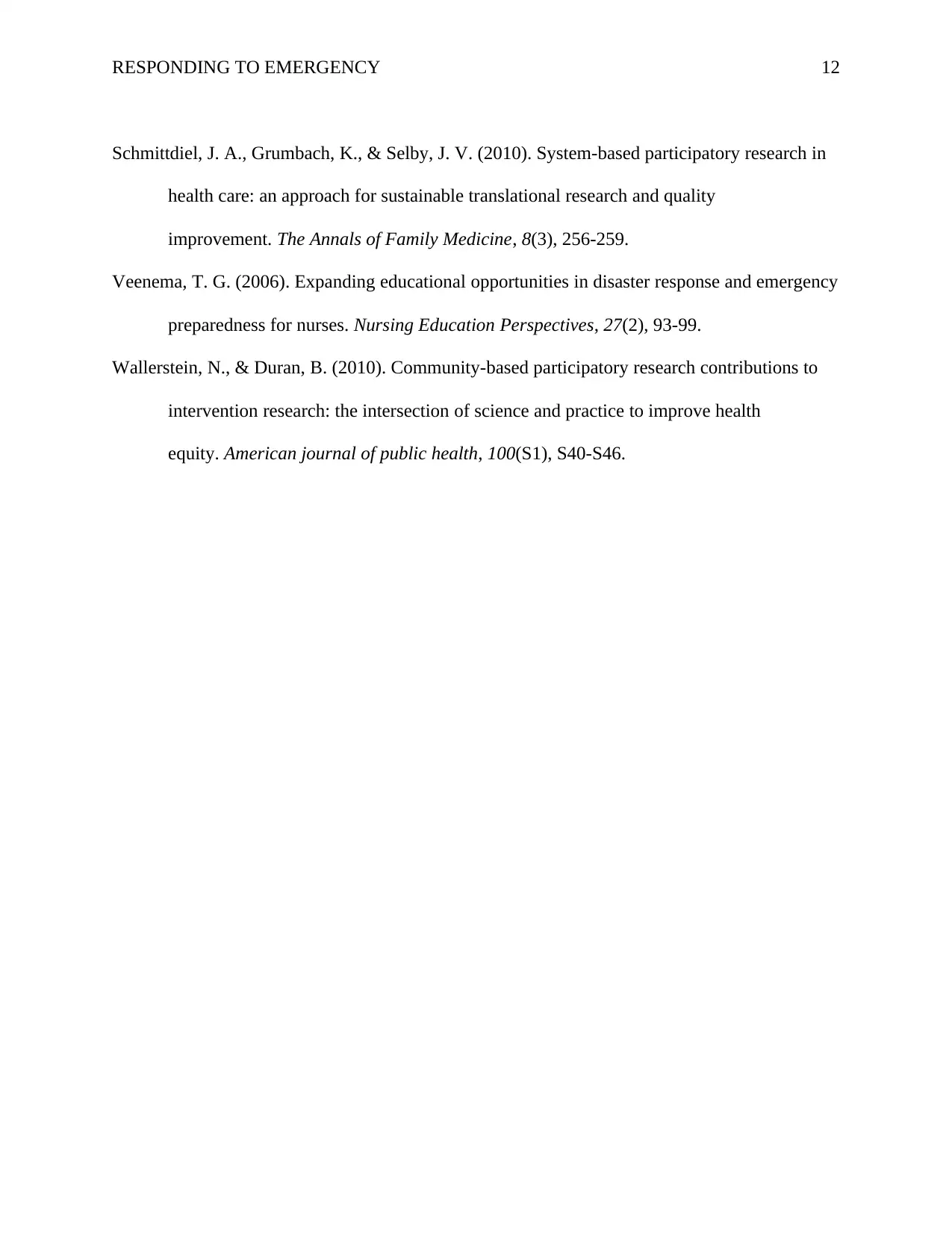
RESPONDING TO EMERGENCY 12
Schmittdiel, J. A., Grumbach, K., & Selby, J. V. (2010). System-based participatory research in
health care: an approach for sustainable translational research and quality
improvement. The Annals of Family Medicine, 8(3), 256-259.
Veenema, T. G. (2006). Expanding educational opportunities in disaster response and emergency
preparedness for nurses. Nursing Education Perspectives, 27(2), 93-99.
Wallerstein, N., & Duran, B. (2010). Community-based participatory research contributions to
intervention research: the intersection of science and practice to improve health
equity. American journal of public health, 100(S1), S40-S46.
Schmittdiel, J. A., Grumbach, K., & Selby, J. V. (2010). System-based participatory research in
health care: an approach for sustainable translational research and quality
improvement. The Annals of Family Medicine, 8(3), 256-259.
Veenema, T. G. (2006). Expanding educational opportunities in disaster response and emergency
preparedness for nurses. Nursing Education Perspectives, 27(2), 93-99.
Wallerstein, N., & Duran, B. (2010). Community-based participatory research contributions to
intervention research: the intersection of science and practice to improve health
equity. American journal of public health, 100(S1), S40-S46.
⊘ This is a preview!⊘
Do you want full access?
Subscribe today to unlock all pages.

Trusted by 1+ million students worldwide
1 out of 12
Related Documents
Your All-in-One AI-Powered Toolkit for Academic Success.
+13062052269
info@desklib.com
Available 24*7 on WhatsApp / Email
![[object Object]](/_next/static/media/star-bottom.7253800d.svg)
Unlock your academic potential
Copyright © 2020–2025 A2Z Services. All Rights Reserved. Developed and managed by ZUCOL.





